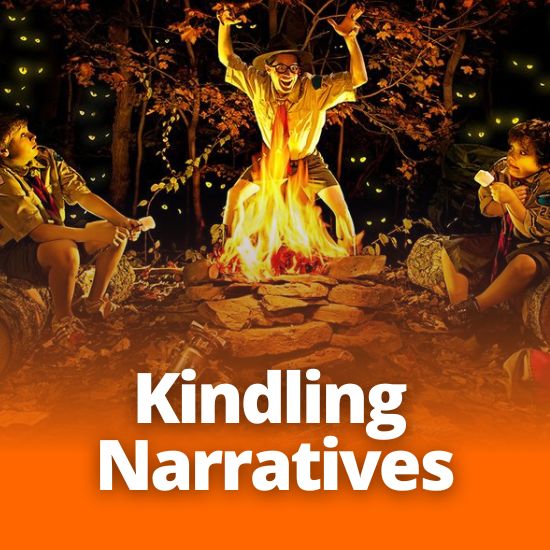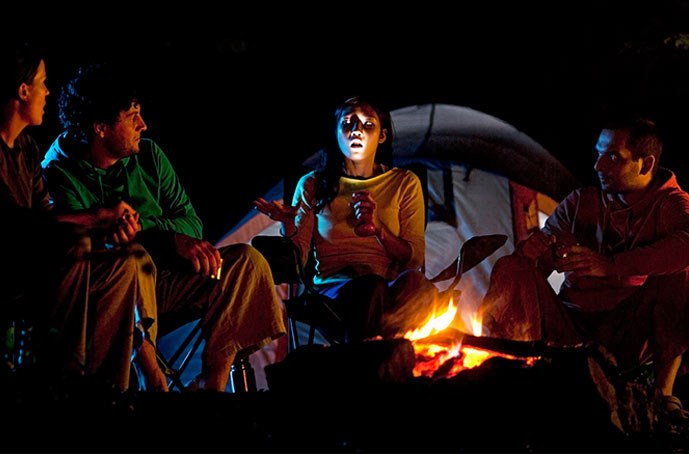
Kindling Narratives
It’s story time! And not just for kids; you want to freak out your friends on the next trip, but just reading off your phone or out of a book won’t cut it! You’ve got to really sell the story, get your audience hooked and then drive it home. The key to any good story is how you tell it, you ever hear someone say they could listen to so-and-so read the phonebook, it’s all in your presentation – for you youngins’ a phonebook was a big book made of paper (not digital, this thing could knock out a moose if you threw it hard enough) we had to use to find someone’s phone number to call them on the landline…ask your parents if you don’t believe me. And then ask about the time before caller ID.
Anywho, if you want to keep people engaged you’ve got to know how to tell your story right!
So, start with your set up, it’s gotta be brief, to the point, and attention grabbing. ‘Once upon a time…” is a classic for a reason, but think of a few others:
“Two households, both alike in dignity, In fair Verona, where we lay our scene, From ancient grudge break to new mutiny, Where civil blood makes civil hands unclean.” –Romeo and Juliet
“If you are interested in stories with happy endings, you would be better off reading some other book. In this book, not only is there no happy ending, there is no happy beginning and very few happy things in the middle.” –A Series of Unfortunate Events
“The terror, which would not end for another twenty-eight years – if it ever did end – began, so far as I know or can tell, with a boat made from a sheet of newspaper floating down a gutter swollen with rain.” –It

These opening lines make us ask questions and want to read further. What is the ‘new mutiny’ between the two households in Verona? The story can’t be that unhappy. Can it? What is “the terror” that would not end for almost thirty years and why is a paper boat so important?
Find your hook, and keep your audience enthralled. Unless you’re a particularly gifted speaker or your story is good enough to get past any speaking flubs you’ve got about five minutes to start your story before your audience gets bored or annoyed. And if they like your story, you get another five, and so on and so on, but every five minutes of storytelling has to be earned or your audience loses focus. Get to the good stuff fast before you slow down to explain the stakes and feelings.
Look again at It, the first three pages build up the suspense; just what is going to happen to Georgie Denbrough and his paper boat, before slowing down and going back in time, introducing the older brother and how the boat came to be. Now the reader has an emotional attachment to both boys and wants to keep reading. I’m not saying you have to be a storyteller of the same caliber as Stephen King, but that book is over eleven-hundred pages long (at least my copy) and you want to read every single one.
Keep your story moving, the difference between giant tomes and a campfire story is that you skip all the extra weight and side stories. Stick to the immediate conflict the story revolves around, the best stories will have multiple conflicts to resolve by the end.
Here’s a simple one (it’s boring but shows the building of conflict on conflict):
“I remember a story I once heard about a cowboy who found a lost cat that curled up on the saddle with him as he rode home. As he rode, a dog came up and wanted to chase the cat so the cowboy threw his hat at the dog to try and scare it off. That exposed his bald head and this gave the cat somewhere to escape from the dog and so they climbed and clawed onto the cowboy’s head. It hurt but the cowboy couldn’t do anything about it because the whole commotion threatened to spook his horse into bucking him off.”
In this example you can see the conflicts building on each other, but in order to keep your audience engaged you have to make their imaginations work with you. So, use strong details and verbs:
“The cat” -> “the tabby cat”
“The dog barked” -> “The dog snarled and snapped”

Words need to elicit feelings: wonder, excitement, fear, hope, intrigue, and so on. They also help keep your story moving without bogging it down with exposition. Instead of saying your character is scared, you can explain that your character’s heart raced and their palms were sweaty. Your audience knows your character is scared from their reactions, and so may elicit the same feelings in them.
Finally, remember that a story is only as good as its conclusion. In many campfire stories this will look like a moral/lesson or reflection, but can often be a joke or a final line stinger that leaves your audience feeling scared, nervous, or relieved.
Looking back at our unfortunate cowboy, we can reflect and joke:
“The cowboy was convinced the animals conspired against him, but the truth is nature just got in the way. Some stories are just too memorable to leave behind, like when a cowboy comes up the road with a cat on his mind.”
You’ve returned to the hook: “I remember” with “too memorable to leave behind” and added a joke: “a cat on his mind,” to focus on the hilarity of the image of a cat sitting on a man’s head.
If you’re making up a story on the spot, or writing one down, try these tips to keep your audience engaged. Beyond that, don’t be afraid to use your whole body. If your story is scary, stay very still as you speak, lower your voice and entice your audience to lean in and stay quiet to hear. And then at the right moment, you can move suddenly or raise your voice to throw them off their guard. Gestures and tone of voice are important to getting the right setting across.
Watch our blog for some campfire stories to tell on your next trip, and let us know if you have any favorites!
(information/quotes from: World Nomads.com; ‘It’ Stephen King; ‘Romeo and Juliet’ W. Shakespeare; ‘A Bad Beginning’ Lemony Snicket)
